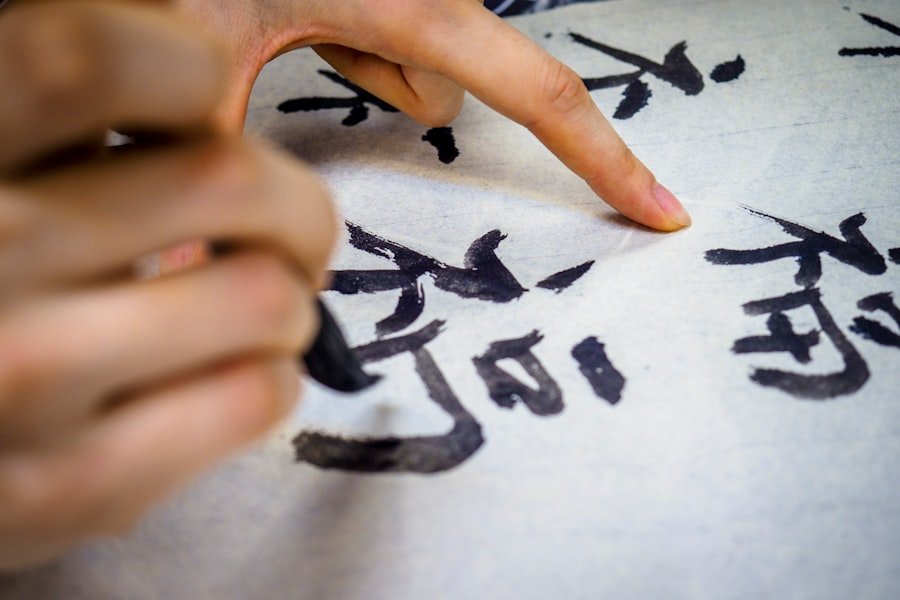Chinese calligraphy is an ancient art form that has been practiced for thousands of years. It is considered one of the highest forms of visual art in Chinese culture and is deeply rooted in the country’s history and traditions. The art of calligraphy involves the skilled and deliberate use of brush and ink to create beautiful characters on paper or silk.
The history of Chinese calligraphy can be traced back to the Shang Dynasty, which existed from the 16th century BC to the 11th century BC. During this time, calligraphy was primarily used for divination purposes, as characters were inscribed on oracle bones. Over time, calligraphy evolved and became a form of artistic expression, with artists using their skills to create beautiful works of art.
Calligraphy holds great importance in Chinese culture. It is not only seen as a form of artistic expression but also as a way to cultivate one’s character and moral values. In traditional Chinese society, calligraphy was considered one of the essential skills for scholars and intellectuals. It was believed that by practicing calligraphy, one could develop discipline, patience, and a sense of harmony.
Table of Contents
ToggleThe Art of Strokes: Understanding the Basics
At the heart of Chinese calligraphy are the strokes. Strokes are the fundamental building blocks of characters and are created by the movement of the brush. There are eight basic types of strokes in Chinese calligraphy: horizontal, vertical, left-falling, right-falling, dot, hook, rising, and turning.
Mastering strokes is crucial in calligraphy because they determine the overall appearance and balance of characters. Each stroke must be executed with precision and control to create harmonious and aesthetically pleasing characters. The brush must be held at a specific angle, and the pressure applied must be consistent to achieve the desired effect.
The Beauty of Simplicity: One-Stroke Characters
One-stroke characters are a unique aspect of Chinese calligraphy. These characters are created with a single continuous stroke of the brush, without lifting it from the paper. They require great skill and control to execute correctly.
One-stroke characters are often used in calligraphy to convey simplicity and elegance. They are minimalist in nature, yet they can still convey complex meanings. Some examples of one-stroke characters include the character for “one” (一), which is a simple horizontal stroke, and the character for “water” (水), which is a flowing stroke that represents the movement of water.
The Power of Symmetry: Balanced Characters
Symmetry is an essential element in Chinese calligraphy. Balanced characters are created by carefully arranging strokes to achieve a sense of harmony and equilibrium. The strokes must be evenly spaced and proportioned to create a visually pleasing composition.
Balanced characters are often used in calligraphy to convey stability and order. They are considered more formal and traditional in style. Some examples of balanced characters include the character for “mountain” (山), which consists of two symmetrical strokes, and the character for “person” (人), which has a balanced composition with two vertical strokes.
The Harmony of Nature: Characters Inspired by Nature
Nature has always been a significant source of inspiration in Chinese calligraphy. Many characters are derived from natural elements such as plants, animals, and landscapes. These characters often capture the essence and beauty of nature.
Characters inspired by nature are used in calligraphy to convey a sense of tranquility and harmony. They reflect the deep connection between humans and the natural world. Some examples of characters inspired by nature include the character for “tree” (木), which resembles the branches and leaves of a tree, and the character for “bird” (鳥), which depicts the shape of a bird in flight.
The Elegance of Movement: Calligraphy as Dance

Calligraphy is often compared to dance because of its emphasis on movement and rhythm. The brush must flow smoothly and gracefully across the paper, creating a sense of fluidity and energy. The artist must have a deep understanding of the dynamics of brushwork to create a visually captivating composition.
Movement is crucial in calligraphy because it adds life and vitality to the characters. It allows the artist to express their emotions and intentions through the strokes. The brush must be guided by the artist’s inner rhythm, creating a unique and personal style. The art of calligraphy is not just about creating beautiful characters; it is about capturing the essence of the artist’s spirit.
The Art of Expression: Characters with Deep Meanings
Chinese characters are not just symbols; they are carriers of meaning and expression. Each character has its own unique history and connotations. Calligraphy allows artists to express their thoughts, emotions, and ideas through the strokes.
Characters with deep meanings are often used in calligraphy to convey philosophical concepts or moral values. They can evoke a wide range of emotions and provoke deep contemplation. Some examples of characters with deep meanings include the character for “love” (愛), which represents affection and compassion, and the character for “wisdom” (智), which symbolizes intelligence and enlightenment.
The Magic of Space: The Role of Negative Space in Calligraphy
Negative space plays a crucial role in Chinese calligraphy. It refers to the empty spaces between strokes or characters. These spaces are just as important as the strokes themselves, as they create a sense of balance and harmony.
Negative space is used in calligraphy to create contrast and emphasize the beauty of the characters. It allows the viewer’s eyes to rest and appreciate the composition as a whole. The careful use of negative space can enhance the overall aesthetic appeal of a piece of calligraphy.
The Beauty of Imperfection: Wabi-Sabi Aesthetics in Calligraphy
In Chinese calligraphy, imperfection is seen as a form of beauty. Wabi-sabi aesthetics emphasize the acceptance of imperfections and the transient nature of life. Calligraphy is not about creating perfect characters; it is about embracing the natural flow and spontaneity of brushwork.
Imperfection adds depth and character to calligraphy. It reflects the artist’s unique style and personality. The presence of subtle variations and irregularities in the strokes can create a sense of authenticity and warmth.
The Legacy of Chinese Calligraphy: Its Impact on Art and Culture
Chinese calligraphy has had a profound impact on art and culture, both within China and beyond. Its influence can be seen in various art forms, such as painting, sculpture, and even graphic design.
The principles and techniques of calligraphy have been incorporated into other art forms, allowing artists to explore new possibilities and push the boundaries of creativity. The expressive brushwork, use of negative space, and emphasis on movement can be found in many contemporary artworks.
Chinese calligraphy has also played a significant role in shaping Chinese culture. It has been used to preserve historical texts, record important events, and convey moral values. Calligraphy is still highly regarded in modern China, with many people practicing it as a form of meditation or as a way to connect with their cultural heritage.
In conclusion, Chinese calligraphy is a beautiful and complex art form that has had a significant impact on Chinese culture and beyond. By understanding the basics of strokes, symmetry, nature, movement, expression, space, imperfection, and legacy, one can appreciate the depth and beauty of Chinese calligraphy. It is an art form that continues to inspire and captivate people around the world.
If you’re interested in learning more about Chinese culture and language, check out the LC Chinese School blog. They have a wide range of articles and resources to help you on your journey. From tips on how to use the word “在 (zài)” in Chinese to understanding the significance of the 12 animal signs in the Chinese zodiac, there’s something for everyone. You can even explore topics like Chinese festivals, traditional musical instruments, and martial arts terminology. Start your learning adventure today by visiting their website: https://lcchineseschool.com/blog/.








